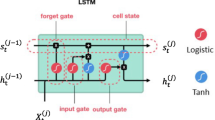Abstract
In economics, the systematic treatment of data to obtain specific properties from long (or short) data series is a main objective. The use of rational models and related numerical methods can be useful to help to predict the behaviour of relevant economic variables with a certain degree of certainty. This paper is concerned with illustrating the application of several numerical methods, in particular, the corner method, epsilon-algorithm, rs-algorithm and qd-algorithm, to the problem of model identification in time series analysis. These methods, closely related to theoretical research in Padé Approximation, are proposed to identify some type of rational structure associated with economic data in different contexts (financial, marketing, farming). Moreover, they incorporate the expectations of exogenous economic variables to improve the fit and forecasting of classic time series models.
Similar content being viewed by others
References
G.A. Baker Jr. and P. Graves-Morris, Padé Approximants, Encyclopaedia of Mathematics and Its Applications, Vol. 53, 2nd ed. (Cambridge Univ. Press, Cambridge, 1996).
J.M. Beguin, C. Gourieroux and A. Monfort, Identification of a mixed autoregressive-moving average process: The corner method in: Time Series, ed. O.D. Anderson (North-Holland, Amsterdam, 1980) pp. 423–436.
A. Berlinet, Estimating the degrees of an ARMA model, Compstat. Lect. 3 (1984) 61–94.
A. Berlinet, Sequence transformations as statistical tools, Appl. Numer. Math. 1 (1985) 531–544.
A. Berlinet and C. Francq, Identification of a univariate ARMA model, Comput. Statist. 9 (1994) 117–133.
A. Berlinet and C. Francq, On the identifiability of minimal VARMA representations, Statist. Inference Stochastic Processes 1 (1998) 1–15.
G.E.P. Box and G.M. Jenkins, Time Series Analysis: Forecasting and Control, revised ed. (Holden Day, San Francisco, CA, 1976).
C. Brezinski, Padé-Type Approximants and General Orthogonal Polynomials (Birkhäuser, Basel, 1980).
A. Bultheel, Laurent Series and Their Padé Approximations (Birkhaüser, Basel/Boston, 1987).
L. Canina and S. Figlewski, The informational content of implied volatility, Rev. Financial Studies 6(3) (1993) 659–681.
P. Claverie, D. Szpiro and R. Topol, Identification des modèles à fonction de transfert: La méthode Padé-transformée en z, Ann. Economie Statist. 17 (1990) 145–161.
C. Francq, Identification et minimalité dans les séries chronologiques, Thèse, Université des Sciences et Techniques du Languedoc, Montpellier II (1989).
C. Gil and R. Alegría, An application of Padé approximation to volatility modelling, Internat. Adv. Economic Res. 5(4) (1999) 446–465.
C. Gil and C. González, Modelización racional de series temporales no causales: Algunas propuestas de caracterización dinámica, Estudios Economía Apl. 8 (1997) 77–107.
C. González, Algunas técnicas útiles para la identificación de estructuras racionales en series temporales, Documento de Trabajo 9, Facultad de Ciencias Económicas y Empresariales, Univ. de La Laguna (1997).
C. González and V. Cano, Determinación de los órdenes de los polinomios de retardo en una función de transferencia: Comparación de algoritmos, Rev. Acad. Canaria de Ciencias 1 (1990) 173–183.
C. González and V. Cano, Especificación de una función de transferencia bajo limitación en el comportamiento de la variable dependiente, Anal. Economía Apl., Murcia (1990) 337–344.
C. González, V. Cano and C. Gil, Comparación de algoritmos para la identificación de una función de transferencia: Una generalización al caso de varios inputs, Rev. Española de Economía, Segunda Época 10 (1993) 163–175.
C. González, V. Cano and C. Gil, The epsilon-algorithm for the identification of a transfer-function model: Some applications, Numer. Algorithms 9 (1995) 379–395.
H.L. Gray, G.D. Kelley and D.D. Mac Intire, A new approach to ARMA modelling, Commun. Statist. Simul. Comput. B 7 (1978) 1–77.
D. Hanssens and L. Liu, Lag specification in rational distributed lag structural models, J. Bus. Econ. Statist. 1 (1983) 316–325.
G.G. Judge, R.C. Hill, W.E. Griffiths and H. Lütkepohl, Introduction to the Theory and Practice of Econometrics, 2nd ed. (Wiley, New York, 1988).
K. Lii, Transfer function model order and parameter estimation, J. Time Series Anal. 6(3) (1985) 153–169.
L.M. Liu and D.M. Hanssens, Identification of multiple inputs transfer function models, Commun. Statist. Theor. Math. A 11(3) (1982) 297–314.
H. Lütkepohl, Introduction to Multiple Time Series Analysis, 2nd ed. (Springer, Berlin, 1993).
H. Lütkepohl and D.S. Poskitt, Specification of echelon-form VARMA models, J. Bus. Econ. Statist. 14(1) (1996) 69–79.
B. Mareschal and G. Mélard, The corner method for identifying autoregressive moving average models, Appl. Statist. 37(2) (1988) 301–316.
H. Padé, Sur la représentation approchée d'une fonction par des fractions rationnelles, Ann. Ecol. Norm. Sup. 9 (1982).
C. Pestano and C. González, C., Characterization of the orders in VARMA models, Przeglad Statystyczny XLIII(3/4) (1996) 183–190.
W.C. Pye and T.A. Atchison, An algorithm for the computation of higher order G-transformation, SIAM J. Numer. Anal. 10 (1973) 1–7.
G.C. Reinsel, Elements of Multivariate Time Series Analysis (Springer, New York, 1993).
P.M. Robinson, Distributed lag approximation to linear time-invariant systems, Ann. Statist. 7(3) (1979) 507–515.
H. Rutishaüser, Der Quotienten-Differenzen Algoritmus (Birkhäuser, Basel, 1957).
G.C. Tiao and R.S. Tsay, Model specification in multivariate time series, J. Roy. Statist. Soc. Ser. B 51 (1989) 157–213.
R.S. Tsay, Model identification in dynamic regression (distributed lag) models, J. Bus. Econ. Statist. 3(3) (1985) 228–237.
P. Wynn, On a device for computing the em(sn) transformation, Math. Tables Aids Comput. 10 (1956) 91–96.
Author information
Authors and Affiliations
Rights and permissions
About this article
Cite this article
González-Concepción, C., Gil-Fariña, M.C. Padé Approximation in Economics. Numerical Algorithms 33, 277–292 (2003). https://doi.org/10.1023/A:1025580409039
Issue Date:
DOI: https://doi.org/10.1023/A:1025580409039




